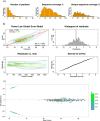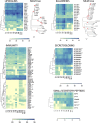On the saliva proteome of the Eastern European house mouse (Mus musculus musculus) focusing on sexual signalling and immunity
- PMID: 27577013
- PMCID: PMC5006050
- DOI: 10.1038/srep32481
On the saliva proteome of the Eastern European house mouse (Mus musculus musculus) focusing on sexual signalling and immunity
Abstract
Chemical communication is mediated by sex-biased signals abundantly present in the urine, saliva and tears. Because most studies concentrated on the urinary signals, we aimed to determine the saliva proteome in wild Mus musculus musculus, to extend the knowledge on potential roles of saliva in chemical communication. We performed the gel-free quantitative LC-MS/MS analyses of saliva and identified 633 proteins with 134 (21%) of them being sexually dimorphic. They include proteins that protect and transport volatile organic compounds in their beta barrel including LCN lipocalins, major urinary proteins (MUPs), and odorant binding proteins (OBPs). To our surprise, the saliva proteome contains one MUP that is female biased (MUP8) and the two protein pheromones MUP20 (or 'Darcin') and ESP1 in individuals of both sex. Thus, contrary to previous assumptions, our findings reveal that these proteins cannot function as male-unique signals. Our study also demonstrates that many olfactory proteins (e.g. LCNs, and OBPs) are not expressed by submandibular glands but are produced elsewhere-in nasal and lacrimal tissues, and potentially also in other oro-facial glands. We have also detected abundant proteins that are involved in wound healing, immune and non-immune responses to pathogens, thus corroborating that saliva has important protective roles.
Figures



Similar articles
-
On the tear proteome of the house mouse (Mus musculus musculus) in relation to chemical signalling.PeerJ. 2017 Jul 7;5:e3541. doi: 10.7717/peerj.3541. eCollection 2017. PeerJ. 2017. PMID: 28698824 Free PMC article.
-
Transcriptomic and Proteomic Profiling Revealed High Proportions of Odorant Binding and Antimicrobial Defense Proteins in Olfactory Tissues of the House Mouse.Front Genet. 2018 Feb 5;9:26. doi: 10.3389/fgene.2018.00026. eCollection 2018. Front Genet. 2018. PMID: 29459883 Free PMC article.
-
Novel OBP genes similar to hamster Aphrodisin in the bank vole, Myodes glareolus.BMC Genomics. 2010 Jan 19;11:45. doi: 10.1186/1471-2164-11-45. BMC Genomics. 2010. PMID: 20085627 Free PMC article.
-
Regulation of Sexually Dimorphic Expression of Major Urinary Proteins.Front Physiol. 2022 Mar 31;13:822073. doi: 10.3389/fphys.2022.822073. eCollection 2022. Front Physiol. 2022. PMID: 35431992 Free PMC article. Review.
-
Multiple roles of major urinary proteins in the house mouse, Mus domesticus.Biochem Soc Trans. 2003 Feb;31(Pt 1):142-6. doi: 10.1042/bst0310142. Biochem Soc Trans. 2003. PMID: 12546672 Review.
Cited by
-
Major urinary protein excreted in rodent hindpaw sweat.J Anat. 2021 Aug;239(2):529-535. doi: 10.1111/joa.13423. Epub 2021 Mar 8. J Anat. 2021. PMID: 33686663 Free PMC article.
-
Signal Detection and Coding in the Accessory Olfactory System.Chem Senses. 2018 Nov 1;43(9):667-695. doi: 10.1093/chemse/bjy061. Chem Senses. 2018. PMID: 30256909 Free PMC article. Review.
-
Proteome characterization of used nesting material and potential protein sources from group housed male mice, Mus musculus.Sci Rep. 2019 Nov 26;9(1):17524. doi: 10.1038/s41598-019-53903-x. Sci Rep. 2019. PMID: 31772257 Free PMC article.
-
Microbial, proteomic, and metabolomic profiling of the estrous cycle in wild house mice.Microbiol Spectr. 2024 Feb 6;12(2):e0203723. doi: 10.1128/spectrum.02037-23. Epub 2024 Jan 3. Microbiol Spectr. 2024. PMID: 38171017 Free PMC article.
-
Sex separation induces differences in the olfactory sensory receptor repertoires of male and female mice.Nat Commun. 2018 Dec 4;9(1):5081. doi: 10.1038/s41467-018-07120-1. Nat Commun. 2018. PMID: 30514924 Free PMC article.
References
-
- Cunningham C. B., Nelson A. C., Ruff J. S. & Potts W. K. MUP expression is linked with sociality not competitive ability in male house mice. Integr Comp Biol 53, E46–E46 (2013).
-
- Novotny M. V. Pheromones, binding proteins and receptor responses in rodents. Biochemical Society 31, 117–122 (2003). - PubMed
Publication types
MeSH terms
Substances
LinkOut - more resources
Full Text Sources
Other Literature Sources
Molecular Biology Databases
Miscellaneous

